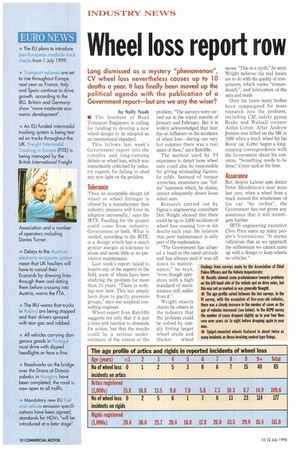Wheel loss report row
Page 12

If you've noticed an error in this article please click here to report it so we can fix it.
Long dismissed as a mystery "phenomenon", CV wheel loss nevertheless causes up to 10 deaths a year. It has finally been moved up the political agenda with the publication of a Government report—but are we any the wiser?
by Sally Nash
• The Institute of Road Transport Engineers is calling for funding to develop a new wheel design to be adopted as an international standard.
This follows last week's Government report into the complex and long-running debate on wheel loss, which was immediately criticised by industry experts for failing to shed any new light on the problem.
Tolerance
"Once an acceptable design (of wheel or wheel fittings) is offered by a manufacturer then industry pressure will force its adoption universally," says the IRTE. Funding for the project could come from industry, Government or both. What is needed, according to the IRTE, is a design which has a much greater margin of tolerance to abuse and needs little or no preventive maintenance.
Last week's report failed to inspire any of the experts in the field, some of whom have been studying the problem for more than 10 years. "There is nothing new here. This has simply been done to pacify pressure groups," says one sceptical consulting engineer.
Wheel expert Ivan Ratcliffe suggests not only that it is just a knee-jerk reaction to demands for action, but that the results could be a serious underestimate of the extent of the
problem. "The surveys were carried out in the winter months of January and February. But it is widely acknowledged that heat has an influence on the incidence of wheel loss—during one very hot summer there was a real spate of them," says Ratcliffe.
The method used by VI examiners to detect loose wheel nuts could also be responsible for giving misleading figures, he adds. instead of torque wrenches, examiners use "toffee" hammers which, he claims, cannot adequately detect loose wheel nuts.
Research carried out by Sigma's engineering consultant Don Wright showed that there could be up to 3,000 incidents of wheel loss causing five or six deaths each year. He believes that poor maintenance is only part of the explanation.
Wright rejects claims by others in the industry that the problem could be solved by simply fitting larger wheel studs and thicker wheel
naves. "This is a myth," he says. Wright believes the real issues are to do with the quality of components, which varies "tremendously", and lubrication of the nuts and studs.
Over the years many bodies have campaigned for more research into the problem, including CM, safety group Brake and Walsall coroner Aidan Cotter. After Andrew Jenkins was killed on the M6 in 1996 when a truck wheel hit his Rover car, Cotter began a longrunning correspondence with the Government about his concerns. "Something needs to be done," Cotter said at the time.
Assurance But, despite Labour spin doctor Peter Mandelson's near miss last year, when a wheel from a truck missed the windscreen of his car "by inches", the Government has not given any assurance that it will investigate further.
IRTE engineering executive Clive Price sums up many people's frustrations: "It seems ridiculous that as we approach the millennium we cannot come up with a design to keep wheels on vehicles."
Findings from surveys made by the Association of Chief Police Officers and the Vehicle Inspectorate: diro Results showed some predominance towards problems on the left-hand side of the vehicle and on drive axles, but Ibis was not as marked as was generally thought.
• The age profile varied between the two surveys. In the VI survey, with the exception of five-year-old vehicles, there was a steady increase in the number of cases as the age of vehicles increased (see below). In the ACP° survey the number of cases dropped slightly up to year four then rose over years six to eight before dropping again ix year nine.
• Spigot-mounted wheels featured in about twice as many incidents as those involving conical-type fixings.
















































































































